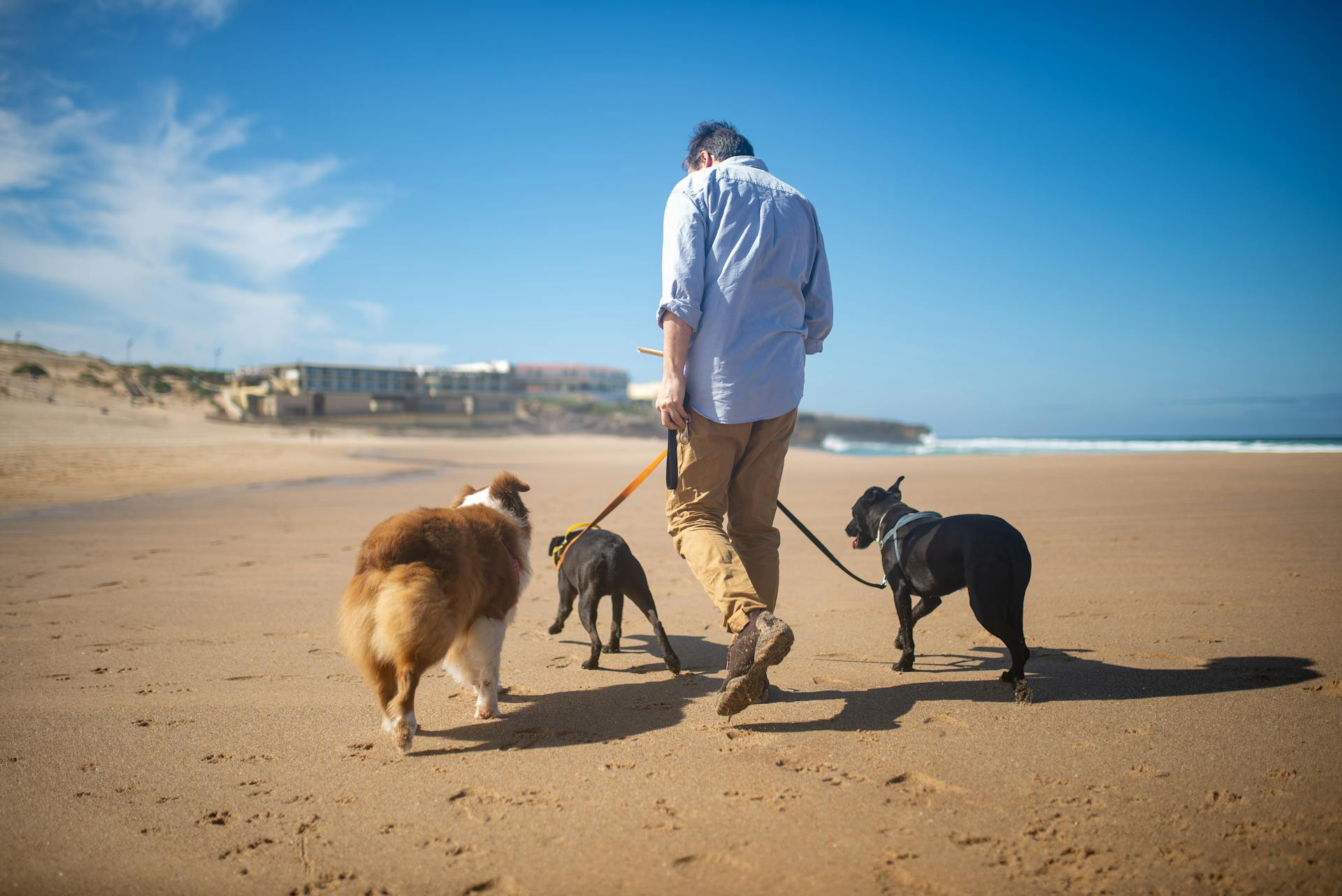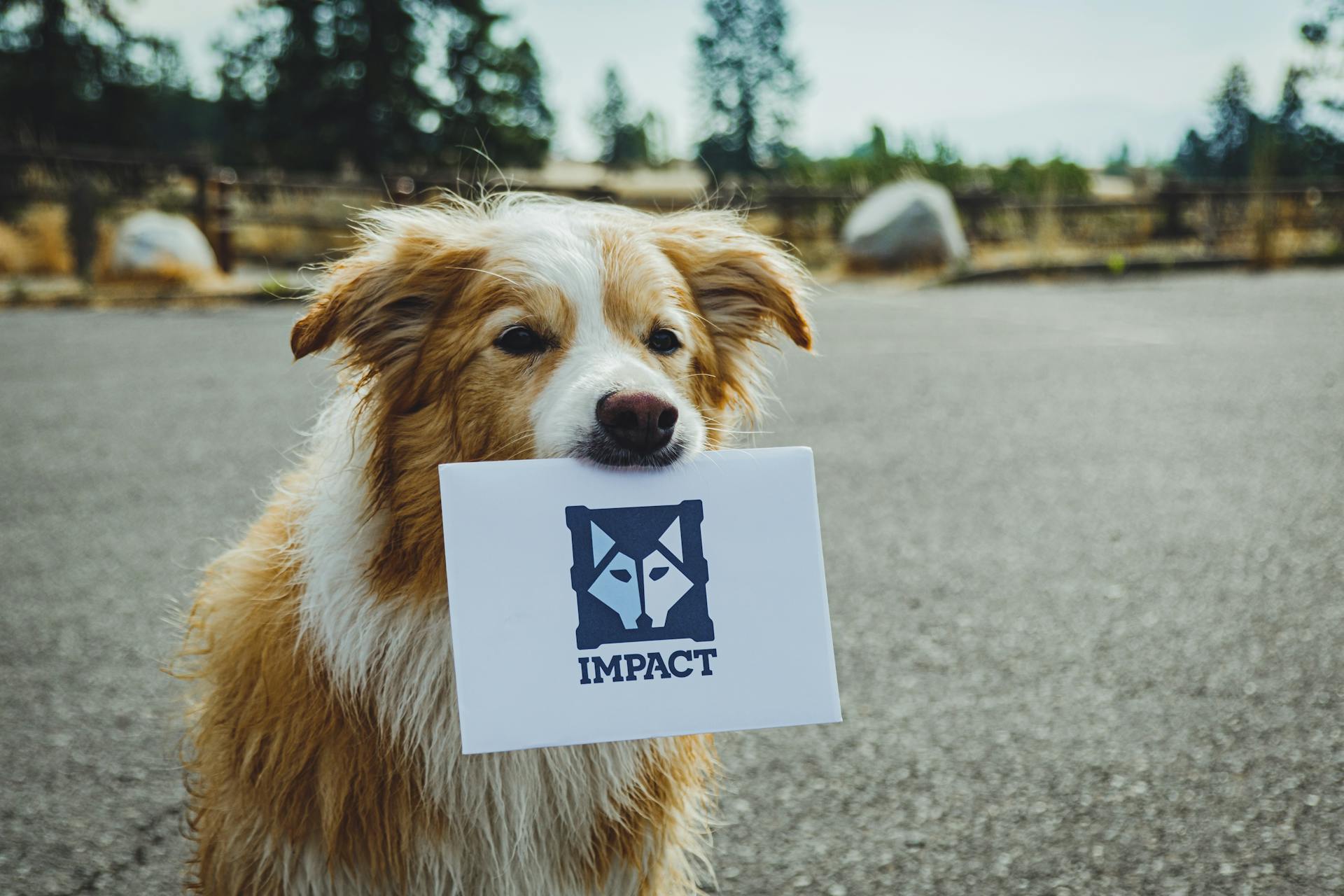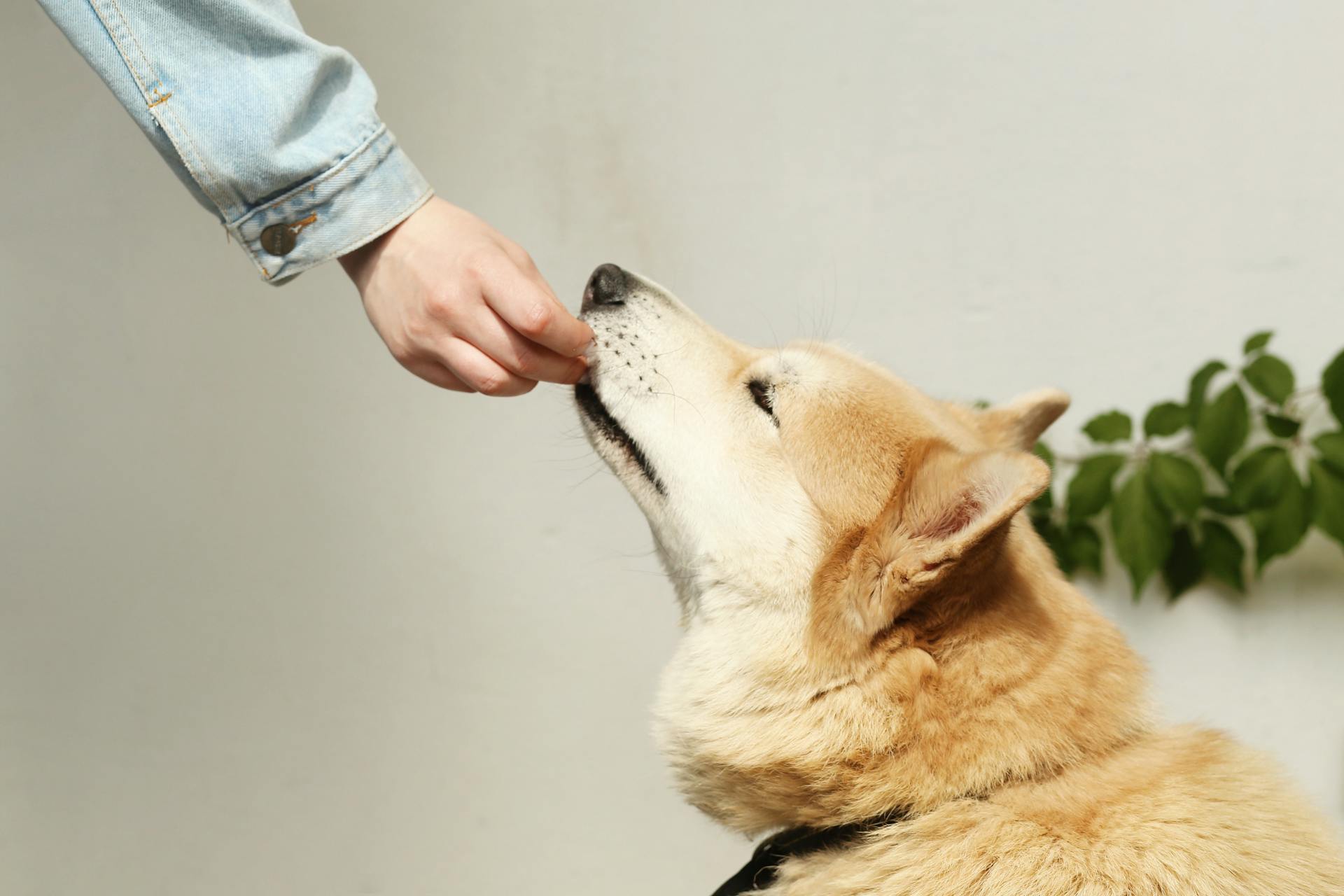
Curing gun shyness in dogs is a process that requires patience, consistency, and positive reinforcement. Dogs with gun shyness can be unpredictable, so it's essential to take things slowly and carefully.
Start by introducing your dog to the sound of a gun at a safe distance, such as 100 feet away. This will help them become familiar with the sound without feeling threatened or scared.
Dogs with gun shyness often have a strong startle response, which can be triggered by the sound of a gun. By gradually exposing them to the sound, you can help them learn to associate it with something neutral, rather than something threatening.
Begin by making the sound of a gun at a safe distance, then reward your dog with treats and praise for remaining calm. Gradually increase the volume and proximity over time, always rewarding calm behavior.
A fresh viewpoint: Is It Safe to Take Dogs to the Dog Park
Understanding Gun Shyness
Gun shyness can be a serious issue for dogs, as seen in the case of Tess, who reacted strongly to the starting pistol, even from a distance of over a hundred yards.
Tess's reaction was not just a minor annoyance, but a clear indication that she was uncomfortable and stressed by the sound of the starting pistol. She stood up, which was out of character for her, and her heart was pounding when her owner returned to the group.
The fact that Tess didn't bolt back to the vehicle suggests that the presence of the other dogs offered some comfort to her, but it's clear that she was not happy in that situation.
What Causes Gun Shyness in Dogs
Gun shyness in dogs can be caused by a combination of genetic and environmental factors, such as exposure to loud noises or traumatic events, which can lead to long-term anxiety and fear.
Research suggests that puppies as young as 8 weeks old can develop gun shyness due to early exposure to loud noises.
In some cases, gun shyness can be passed down through generations, indicating a possible genetic component.
A traumatic event, such as being startled by a loud noise or a physical encounter with a gun, can also trigger gun shyness in dogs.
The first time a dog is exposed to a loud noise, such as a gunshot, can be a critical moment in determining whether they will develop gun shyness.
Some breeds, such as hunting breeds, may be more prone to gun shyness due to their breeding history and exposure to loud noises.
Broaden your view: Dog Breeds Watch Dogs
Recognizing Signs of Gun Shyness
Gun shyness can be a subtle condition, but there are some telltale signs to look out for. A person with gun shyness may exhibit fear or anxiety around firearms.
Some common physical signs of gun shyness include a racing heart, sweating, and trembling. People with gun shyness may also exhibit avoidance behaviors, such as refusing to be around guns or avoiding situations where guns are present.
A person with gun shyness may also exhibit behavioral signs, such as being overly cautious or hesitant around firearms. They may also exhibit a lack of interest in guns or shooting sports.
Gun shyness can be a complex condition, but recognizing the signs can help you support someone who may be struggling with it. By being aware of the physical and behavioral signs of gun shyness, you can help create a safe and supportive environment for them.
Gun Nervous
Gun nervous dogs are a common issue for hunters and their canine companions. This can be a challenging problem to overcome, but with patience and the right approach, it's possible to help your dog feel more comfortable around loud noises like gunshots.
You can start introducing your puppy to gunshots as early as 9 weeks old, but from a safe distance of 150 feet. This allows them to gradually get used to the sound without feeling overwhelmed. Professional trainers recommend using .22 blanks for a softer noise, which can help your puppy become desensitized to the sound.
It's essential to remember that every dog is different, and some may react more strongly to loud noises than others. For example, Tess, a dog in one account, stood up when she heard the starting pistol, which was a clear sign that she was not happy. This reaction was out of character for Tess, and her owner knew that she needed to take things slowly.
You can try using positive reinforcement techniques, like playing with a loud noise-making toy, to help your dog become desensitized to gunshots. For instance, Mary Wigals used a Big Red plastic Bat and Ball to help her GSP, Grizz, get used to the bang of the bat and ball, and he eventually became fine with gunshots.
Here's a rough outline of how you can help your dog overcome gun shyness:
- Start introducing your puppy to gunshots from a safe distance (150 feet) at around 9 weeks old
- Use .22 blanks for a softer noise
- Gradually increase the volume and proximity to the sound
- Use positive reinforcement techniques, like playing with a loud noise-making toy
- Be patient and take things slowly, as every dog is different
Training and Rehabilitation
Hiring a professional trainer can be a good idea if your dog has an extreme phobia of loud sounds.
A trainer can help you handle the situation and ensure a positive outcome. They have experience with dogs and know how to tailor their approach to your dog's unique needs.
To start the process, try using a blank pistol for a quieter shot and then repeat the entire process with a loaded gun. The level of fear in your dog will determine how slow you should go.
Consider reading: How to Become a Dog Trainer for Service Dogs
Going too fast can have negative consequences, so patience is key to success. Preventing the problem is better than trying to cure it.
Dogs that are well-kept by owners are more trusting, so make sure to invest in your dog's grooming. Grooming can go a long way in making your dog feel at ease.
Here are some steps to follow when training a gun shy dog:
- Start with small sounds, such as banging your hand on a solid surface or clapping
- Offer your dog a treat as soon as you make the sound to link the stimulus to a positive response
- Gradually increase the volume of the sound
- Use positive reinforcement techniques, such as offering treats or toys
- Be patient and go at your dog's pace
For example, Mary Wigals' German Shorthaired Pointer (GSP) was gun shy, but she was able to overcome the fear by using a Big Red plastic Bat and Ball, which made a loud sound. They played together 4 to 5 times a day for about 3 weeks, and the dog was fine.
Cheryl-Haskins suggests using positive reinforcement and desensitization techniques to help your gun shy dog overcome its fear of loud noises like gunshots.
Intriguing read: Gun Shy Dog
Prevention and Cure
You can start training your dog to be less gun shy as early as 9 weeks old, but from a safe distance of 150 feet. This early training can help prevent gun shyness from developing in the long run.
For another approach, see: Spirit Dog Training Reactivity
Proper training involves gradually exposing your puppy to louder noises, starting with .22 blanks and moving on to pistols and then shotguns. It's essential to move your puppy away from the sound as it gets louder and only bring it closer if it doesn't show signs of fear.
The Master's Voice Gunshy Cure System is a product that uses state-of-the-art behavior modification methods to help your dog overcome gun shyness. This system includes an instruction manual that guides you through a series of training levels, which can be completed in just a few minutes a day.
Broaden your view: Gun Dog Training
Comments
The Gunshy Cure System is a product that uses state-of-the-art behavior modification methods to help dogs overcome gunshyness.
It's a system that's based on in-depth observation, analysis, and testing with gunshy dogs, and it includes a gradual increase in the volume of gunfire, frequency of firing, and duration of gunfire, as well as changes to the source and nature of the sound.
The system takes just a few minutes a day to use, with results in three to six weeks.
Results may vary, as the author of the Gunshy Cure System notes that it may not work for every dog, especially those that are inherently gunshy.
The system includes an instruction manual to help users succeed at each level of training, and it's designed to make your dog think shotguns are as soothing as music.
The KennelCalm program is also included at no additional cost, which can accelerate the training process.
Consider reading: All about Dogs Dog Training
How to Prevent a Gun Shy
You can start training your puppy to get accustomed to gunshots and other loud noises as early as 9 weeks old. According to professional trainers, it's essential to start from a distance of 150 feet and use .22 blanks for a softer noise.
Gradually moving on to a pistol and then eventually a .410 gauge shotgun is crucial in the training process. This will help your puppy get used to the loud noises associated with hunting.
Proper training involves moving the puppy away from the sound as it gets louder and only bringing it closer if it doesn't show signs of fear. This will help your puppy build confidence and become less gun-shy.
Most gun-shy dogs are made rather than born, so it's essential to take proactive steps in training your puppy. A horrible experience, like the one a Labrador had when she was three months old, can lead to a lifelong fear of loud noises.
The probability is that your puppy will be less susceptible to fear of noise if you start training them early and correctly.
Frequently Asked Questions
How do I stop my dog from being hand shy?
To help your dog overcome hand shyness, start by waiting for them to move towards your hand, even if it's just a small movement, and reward them with treats. Gradually, with consistent repetition, your dog will learn to associate hand presence with positive reinforcement.
Sources
- https://www.sportdog.com/hunting-training-tips/gun-shy-dogs-can-blossom
- https://www.heartlandlodge.com/hunting-news/pheasant-quail/is-your-dog-gun-shy/
- https://comforttac.com/blogs/news/how-to-train-a-gun-shy-dog
- https://totallygundogs.com/gunshy-dog-can-it-ever-be-cured/
- https://mastersvoice-dog.com/product/150/
Featured Images: pexels.com


